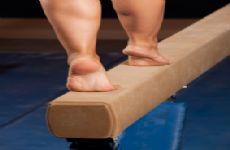|
I see it happen all the time on exercise forums or via my friend Facebook: Exercisers (from enthusiasts to newbies) get so pumped up about a particular workout that it's all they can do, talk about or think about...for a while anyway. After a few days (or a couple weeks if they're lucky), these people are already gung ho for something else. While their enthusiasm and consistency for working out is a very good thing, they ultimately end up complaining for not getting results. But wait: Isn't a good thing to try new workouts to create that "muscle confusion" or get better results? Yes—to a point. But if you're dipping your toe in too many different workout "waters" without ever fully diving in, it can be a recipe for frustration! Yes, its great to mix up your workouts, try new things to keep from getting bored, and to continue challenging yourself. However, if you don’t give your body time to progress or a chance to master certain movements, you may never see results! A little repetition in your workouts is a good thing; it will make you stronger and more efficient, build cardiovascular stamina and muscle strength, and improve your coordination and skill thanks to practice and repetition over time. Think about it this way: You didn’t learn to swim the first time you jumped in the water, did you? And you didn’t simply try to swim one day, then move on to a one-day stint of learning to ride a bike or to play basketball, did you? No (at least I hope not!). You kept practicing and learning new skills like how to hold your breath underwater, how to tread water, how to perform different strokes. Over time, you got better and better at it, and were able to swim better, faster, more efficiently. Mastering your workouts should be similar. If you do happen to find yourself suffering from a little "exercise attention deficit disorder," where you can't commit to any one program or workout for very long, keep these tips in mind when creating your own personal workout program: 1. Try to stick with the same weekly routine for about 4-6 weeks. While everybody is different, adaptations to exercise (like strength gains, cardiovascular improvements, etc.) usually occur around 4 to 6 weeks. That means in order to actually feel, see or notice some changes from your workouts, you’ll need to be consistent with your plan for at least a good month. I’ve seen too many folks quit after two weeks into a plan because they weren’t losing weight. Focus on how you feel (like feeling stronger or moving more easily during the workout)—not how you look—and the rest will take care of itself over time. If sticking to one workout plan is driving you crazy, create a simple calendar. List your workouts for each day, then try to find satisfaction in completing the full plan of 4-6 weeks of that strength-training program. 2. Vary your workouts on a weekly basis. Sticking with the same plan doesn’t have to equal boredom! Mixing things up on a day-to-day basis fights exercise ennui and helps to balance out your program. A weekly routine should include a mix of cardio, strength and flexibility work at both high and low intensity levels; the only repetition should be within workout categories. So do the same strength-training class/exercises/DVD twice in a week, and maybe the same cardio workout (running, Spinning, Zumba, etc.) so that you can build the routine and see improvements. Leave a day or two for "whatever you want" workouts to mix things up and keep your week exciting. 3. Focus on fun first, fitness second. One of the biggest reasons I think it’s easy to get pulled into the "short attention span" trap is that it’s so easy to be persuaded to try that latest and greatest exercise program, gadget or trendy routine (it looks so great on that infomercial!). And when we try it, its nothing like the commercial said it would be. In fact, it’s usually a) boring, b) too hard, c) exhausting, or d) all of the above. So instead of looking to advertisements to tell you what your workout should be, ask yourself first: What type of movement do I enjoy? If you’ve always loved moving to music, how about starting with a music-based workout plan? Try some Zumba DVDs, or take that hip hop dance class, or make an awesome workout playlist to walk to. If you prefer the stress-reducing effects of exercise, try mind-body techniques like yoga, Pilates, or zone out in the quiet, repetitive nature of swimming. Finding ways to incorporate what you love into your own special workout program can help you look forward to your workouts and make you more likely to stick with long term. And while it is important to be consistent with a program in order to get results, it doesn’t mean that you should feel obliged to stick with a workout or plan that you simply don’t like or one that doesn’t work for your body or fitness level. As you experiment with finding what works best for you and what you enjoy most, be sure to listen to your body, and create a rotation with your workouts that allows for both mastery and variety. You may find yourself feeling better, stronger and even more inspired to keep on sweating! |
Popular Entries
More From SparkPeople
|


.jpg)


















